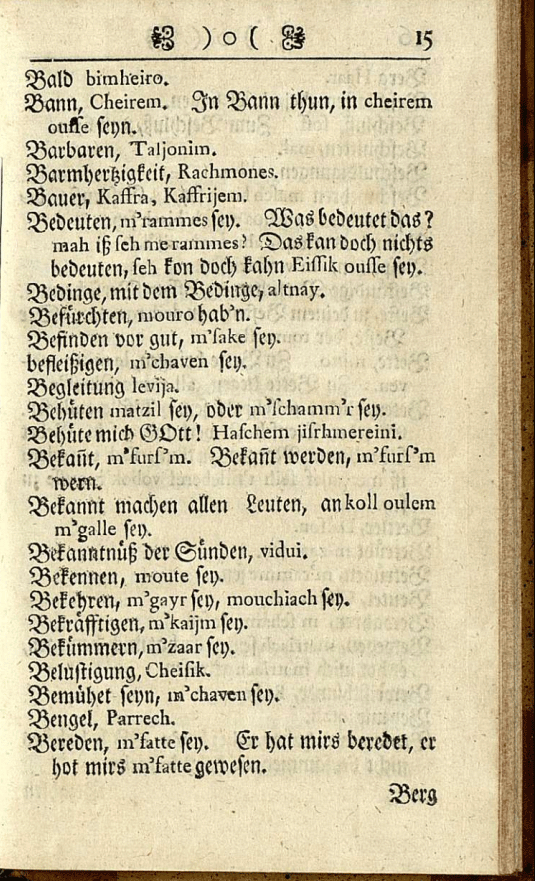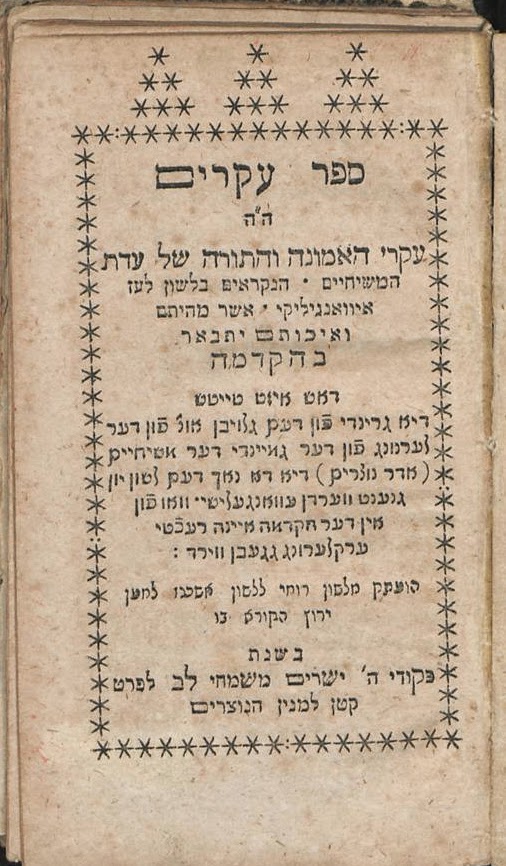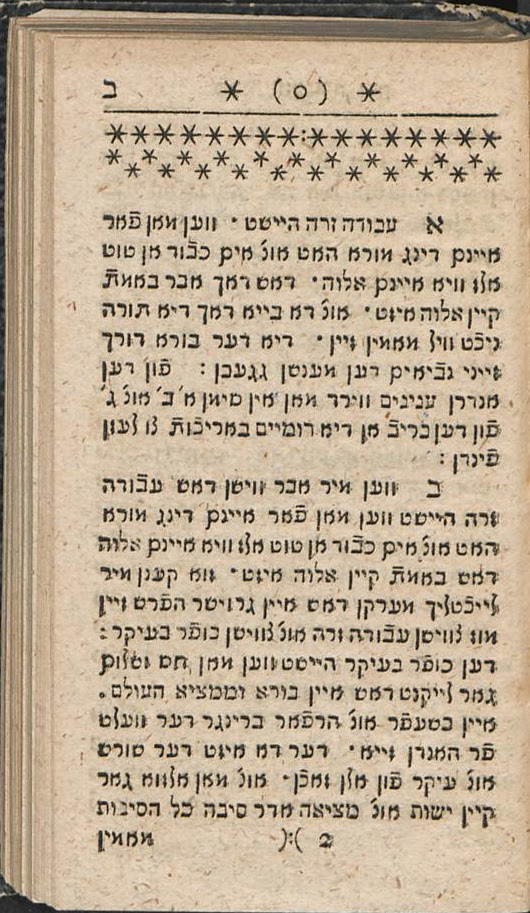The other day I did a post about Callenberg's 1736 lexicon of the Hebraic elements of Yiddish, which I jokingly called the "first dictionary of Yeshivish." The reference is to the ill-considered allusively named Frumspeak: the first dictionary of Yeshivish (Aronson 1995).
The truth is that the Judaic and Hebraic elements in the Jews' vernacular have long been a subject for scholarly study. For example, Mahari"l Zunz explored these in his magnum opus (link). Here is some footnotes from Zunz, where he categorizes terms by topic:
Chassidic Yiddishists have published literature along the same lines, and perhaps uniquely, the Yeshvishe olam even have a Yiddish enthusiast in Rabbi Dovid Cohen, who has published השפה יידיש הקדושה in three quntreisim.[1]
But to go back in time a bit further, the truth is that Callenberg's work was preceded by three years by an earlier lexicon. This one was quite primitive, and more prone to mistakes, but in certain respects much earthier and probably closer to a slightly lower class vernacular than Callenberg's. Another interesting element of this dictionary is that although it does offer a guide to reading "Vayberteitch" the entries are written in Latin transliteration, preserving the nuances of early 18th century Ashkenazic pronunciation, although it must be recalled that it is hardly meticulous enough to be fully reliable.
Here is the title page:
The Kurtze und gruendliche anweisung, zur teutsch-juedischen sprache was published in 1733 by PhilogLotto, an obvious pseudonym. I don't know who precisely identified the author, but we see on pg.223 in v.2 of the language classic Mithradites by Johann Christoph Adelung (1809) the following in the bibliography on Yiddish:
Here Philoglotti is identified as J.P. Lütke. Alas, I have found no further trace of him, so I cannot say what his background or education was, or even what "J. P." stands for.
Here is a sampling. I will add the proper Hebrew or Yiddish spelling, but keep in mind that all the entries are in Latin letters. Thus, the spellings I give here are what appear in the original. Whereas Callenberg's lexicon had "emunah" for "credit." This one has "nemones" (נאמנות). "Brandtewein" (brandy) is "jainsorof" (יין שרף). For thief and thievery it has "ganff" (גנב) and "gneive" (גנבה).
It incorporates the famous Ashkenazic pronunciation of the cholem (/ou/ as in "couch"). For example, a fool "einsaeltiger narr" is a "Schoute" (שוטה). Fast days are "joumei t'schuve" (יומי תשובה). The entry for "Freude" (joy) gives "simche" (בשמחה) with the expansion for great joy, "b'simche g'doule" (בשמחה גדולה). Kupffer (copper) is "Nechousches"(נחושת).
The compiler seems to have had a decent ear, but a poor understanding of the Hebrew basis for the words. For example, on page 21 there is the exclamation "Rachmonolitz lan!" (רחמנא לצלן). "Familie" is "ma schpoche" (משפחה), the good wish "haba alenulethoba," (הבא עלינו לטובה) etc. In his listing of the Hebrew months, he makes a mistake like transcribing "Februarius" as "Schbas" (שבט), where he mistakenly thought that it is spelled שבת.
Interestingly, on pg. 31 it gives "majim medino" (מים מדינה) for Holland. Water Country? I've never heard of that before. I guess it's an allusion to the numerous canals in this low-lying country. "Historie" has two entries, "m'gille" (מגילה) and "maasse" (מעשה). There's an entry for an "ouhefnoschim" (אוהב נשים), a "liebhaber" (lover). Now, what in the world can that be doing in the Yiddish lexicon from 1733! The active form of "kiddush Hashem" is here - "mekudesch haschem" (מקודש השם) - and it refers to "martyrer werden." Nowadays people are told to "make a Kiddush Hashem" by being courteous and pleasant. In 1733 giving one's life for Judaism was no distant memory.
According to this it was typical to call a "mutter" "Imme" (אמא). If a person is doing something "Im Nahmen Gottes," they are doing it "l'schem schomajim" (לשם שמים). A bathroom - "privet" - is a "bais hakisse" (בית הכסא), and a "priester" is a "gallach" (גלח). A "rabbiner" is a "raaf" (רב), Shabbos is "shabs," (שבת), Satan is "sotn," (שטן), and the holy Scriptures is "Toure hakdousche" (תורה הקדושה)."Hakbodes" (הקפדות) and "chumros" (חומרות) are synonyms, translations for "schwierigkeiten" (difficulties). "Sondern" is "adraba" (אדרבא), a genuinely Yeshivish word. "Teuffel" (devil) has fully four entries: aschmedai (אשמדי), masik (מזיק), sotn (שטן) and scheid (שד). "Teutsche" is "Aschkenes" (אשכנז). A terrible predicament or time period is an "Eszora" (עת צרה). "Wie?" is "lomme?" (למה). Finally, here's a good (and timely) one: "Weihnachten" (Christmas) is "Chanike" (חנוכה).
Here's the guide to reading the Hebrew alphabet in vayberteitch in the beginning:
Following this is a sample Yiddish letter with each part meticulously deciphered. For example, the abbreviation לפק ("lephak") is explained as "l'phdak kot'n." This would seem to be another example of PhilogLotto's inexpertise in the language, since לפדק means nothing (it should say לפרט קטן). Since there are two mistakes in the one word, I'm assuming it's not merely a typographical error:
Here are various sample pages:
At the end of the book is a few pages of text of German interspersed with many of the sort of words found in the lexicon. Here's a sample, which I included because it's all about Kabbalah, complete with a Ba'al Shem doing his deed.
Since we began this post referencing Callenberg, the Orientalist missionary who wrote the second (more sophisticated Yiddish lexicon) I thought it would be fitting to add here a few samples of his other work.
For example, here is the title page of his Yiddish translation of the Lutheran Augsburg Confession, titled ספר עקרים. Say what you will, there is no doubt that Christian missionaries then were better at making their literature appear as a truly Jewish book. The date is even audaciously written Jewish-style as a chronogram, בשנת פקודי ה ישרים משמחי לב, although let's be honest, this is an amateur attempt. It even writes that this date - adding up to 732 - is according to the פרט קטן למנין הנוצרים, that is 1732 in the Christian reckoning.
Here are some pages:
The next book, a missionary tract aimed at Jews is pretentiously titled מהות העבודה זרה,:
[1] Rabbi Cohen's book is a mixture of erudition and bizarrity (you have a better word?). It includes many charming - yet utterly wacky - suggestions, such as the following entry: לֻלֻלֻלֻ , which Yiddisher mamas say to lull their baby to sleep (לולוביי בלע"ז). Rabbi Cohen writes that he heard from "חכם אחד" that this is to instill in the children the four lameds: ללמוד ללמד לשמור לעשות. Although he distances himself from the explanation that שנאפס is an anagram of שהכל נהיה בדברו noting that schnapps means, well, schnapps in German, he explains מוטער (mother) as having a source in the Midrash Ruth עיקר מוטרין לא היה לה. (Re schnapps, the idea is that that schnapps is also known as יין שרף. So the point is that *this* is the "wine" that one blesses with a she-hakol.)
















You bring up an interesting topic that seems to be the habit of members of the tribe and "outsiders" alike throughout the ages: knowingly or unknowingly combining or slurring multiple words belonging to a phrase.
ReplyDeleteFor example -
- kinnehora (kin*ayin*ho*rah)
- barmitzva (bar*mitzvah)
- yuntif (yom*tov)
- shaloshudes (seudas*shlishi)
- mazeltov (mazal*tov)
- memunafshuch (me*muh*nafshuch)
In some cases, it's a reflection of the speaker's "insider" status. In others, it reflects a certain unfamiliarity with the mamahloshen (er, mama*lashon).
Interesting as always, Fred. But are you sure the German "ou" is meant to be pronounced as in the English "couch"? In twenty-first-century German, they get that sound with "au" (which doesn't necessarily mean that was the case in the 18th c.). Do you know of any German words, other than direct borrowings from French or English, that have an "ou," and if so, how are they pronounced? Intuitively, if "ou" isn't a digraph with a special sound, it would represent an "o" with a diphthongal glide--what we Yanks consider a long "o." (And who says my intuition has to be right?)
ReplyDelete